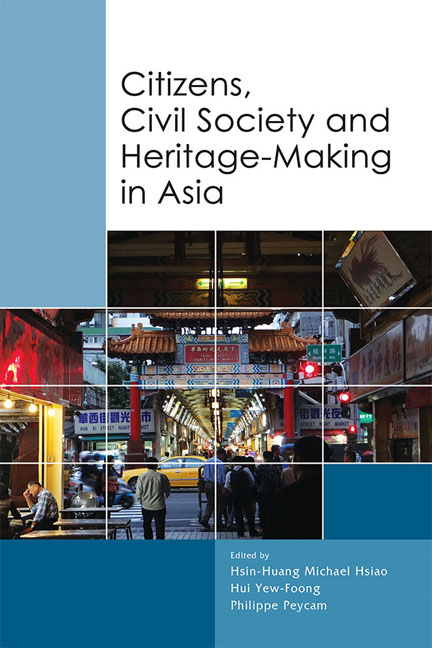Book contents
- Frontmatter
- Contents
- Contributors
- 1 Introduction: Finding the Grain of Heritage Politics
- 2 Heritage, Identity and Power
- 3 Heritage-Making and Post-coloniality in Yangon, Myanmar
- 4 Living Heritage of Ruins? Contesting the Paradox in Trowulan's Majapahit Heritage
- 5 The Reconstruction of Heritage in Rural Vietnam: An Analysis of State and Local Dynamics
- 6 Performing Cultures, Negotiating Identities: The Cultural Politics of Indigenous Cultural Villages in West Malaysia
- 7 Constituting Philippine Filmic and Linguistic Heritage: The Case of Filipino Regional Films
- 8 Encounter and Counter-Narratives of Heritage in Macau
- 9 Cultural Activities of the Chinese Community in Post-war Myanmar
- 10 Chinese Street Opera in Singapore: Heritage or a Vanishing Trade
- 11 Policy Formation and Civil Society Engagement in Heritage-Making in Taiwan: A Historical Examination
- 12 Becoming Taiwanese: Appropriation of Japanese Colonial Sites and Structures in Cultural Heritage-Making — A Case Study on the Wushantou Reservoir and Hatta Yoichi
- 13 Defining Culture in the Heritage Preservation of Taiwanese Veterans’ Villages: The Case of Zuoying
- 14 Tobacco Crop Memories in Taiwan: The Heritage of a Deadly Agriculture
- Index
14 - Tobacco Crop Memories in Taiwan: The Heritage of a Deadly Agriculture
Published online by Cambridge University Press: 03 January 2018
- Frontmatter
- Contents
- Contributors
- 1 Introduction: Finding the Grain of Heritage Politics
- 2 Heritage, Identity and Power
- 3 Heritage-Making and Post-coloniality in Yangon, Myanmar
- 4 Living Heritage of Ruins? Contesting the Paradox in Trowulan's Majapahit Heritage
- 5 The Reconstruction of Heritage in Rural Vietnam: An Analysis of State and Local Dynamics
- 6 Performing Cultures, Negotiating Identities: The Cultural Politics of Indigenous Cultural Villages in West Malaysia
- 7 Constituting Philippine Filmic and Linguistic Heritage: The Case of Filipino Regional Films
- 8 Encounter and Counter-Narratives of Heritage in Macau
- 9 Cultural Activities of the Chinese Community in Post-war Myanmar
- 10 Chinese Street Opera in Singapore: Heritage or a Vanishing Trade
- 11 Policy Formation and Civil Society Engagement in Heritage-Making in Taiwan: A Historical Examination
- 12 Becoming Taiwanese: Appropriation of Japanese Colonial Sites and Structures in Cultural Heritage-Making — A Case Study on the Wushantou Reservoir and Hatta Yoichi
- 13 Defining Culture in the Heritage Preservation of Taiwanese Veterans’ Villages: The Case of Zuoying
- 14 Tobacco Crop Memories in Taiwan: The Heritage of a Deadly Agriculture
- Index
Summary
Agricultural landscapes have long been an important vehicle for postproductivist rural economies seeking to repackage themselves as places for tourism. Preservation activities, heritage operations, and commemorative routines are now intensifying their focus on the agricultural past to emphasize their distinctiveness and to shore up fragile local identities by conserving, celebrating and attending to past methods of cultivation, techniques of animal husbandry and other historic forms of land use. These places of agricultural history are labelled “cultural landscapes” by UNESCO's World Heritage sites programme, and include vineyards in Italy (Puleo 2013), rice terraces in the Philippine Cordilleras (Guimbatan and Baguilat 2006), as well as the pastoral landscapes associated with the English picturesque (Matlass 2005). Seemingly without controversy, the historic cultivation of tobacco is counted equally as agricultural heritage and often interpreted in ways similar to crops that are far more benign. Generic interpretive formulae for agricultural heritage such as “the taming of nature through dedicated hard work”, “working in harmony with nature”, “technological advancement” and “idiosyncratic local practices and architectures” are all familiar examples.
Tobacco heritage's unproblematized repetition of the “human harmony with nature” theme avoids the overwhelmingly destructive effects of this plant's cultivation. According to the World Health Organisation's figures, a hundred million deaths were caused by tobacco in the twentieth century and, they warn, if current trends continue there will be up to one billion deaths in the twenty-first century. It is not insignificant that eighty per cent of these deaths will occur in the developing world.1 So what are we to do with the historical spaces of tobacco cultivation and manufacture? What kinds of messages do we want to use these spaces to convey?
Most kinds of agricultural heritage is overt and highly visible precisely because it helps to enhance the value of the farmed commodities associated with it, as traditional, natural, pure and wholesome, for example. Tobacco is unusual in that stories of origins and links to the soil, so familiar in artisan products like wine, pasta, cheese or bread, are silenced by state regulations on advertising.
- Type
- Chapter
- Information
- Citizens, Civil Society and Heritage-Making in Asia , pp. 305 - 324Publisher: ISEAS–Yusof Ishak InstitutePrint publication year: 2017



